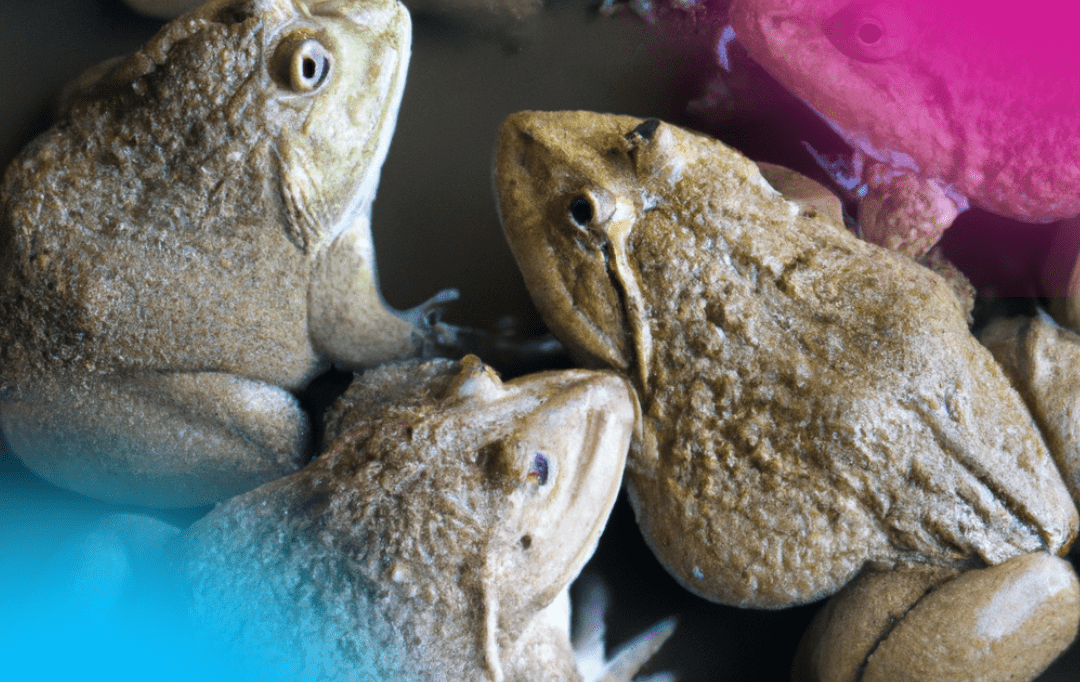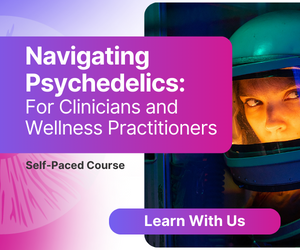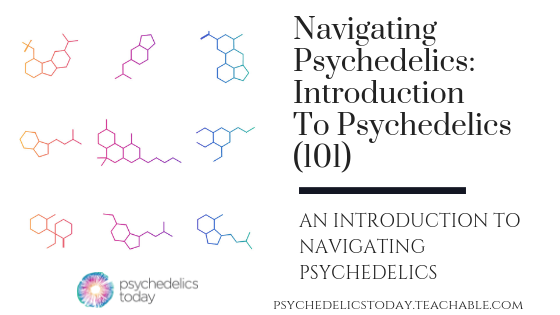by Malin Vedøy Uthaug
The consumption of 5-MeO-DMT by inhaling bufotoxins from the Colorado River toad (lat. Incilius Alvarius), also known as “Bufo Alvarius”, “El Sapo/Sapito”, “Bufo”, and “Toad”, has become increasingly popular in a variety of underground ceremonial settings in recent years. Furthermore, due to the realization of the potential 5-MeO-DMT holds for therapy it has also become a new interest in psychedelic research.
When I started psychedelic research for my dissertation at Maastricht University in fall 2017, there was no research addressing the subjective effects from inhalation of bufotoxins in humans. Thus, I brought it upon myself to investigate this further as the consumption of the so-called “toad-medicine” was booming worldwide.
The primary aim of the study was to investigate whether the bufotoxins from the toad, which is known to contain significant amounts of 5-MeO-DMT, as well as other compounds, produces long-lasting changes on affect and thinking style. The second objective was to assess whether the acute and long-term effects of the bufotoxins depend on the degree of ego dissolution and altered states of consciousness that was experienced during the ceremony. The preliminary evidence of this study was presented at the Beyond Psychedelics conference in Prague in June, and the recording of this presentation is now circling around on the web.
Even though the study results are very interesting and important to highlight due to the consumption of the “toad-medicine” worldwide, I think it is of equal importance, if not more, to shed light on another side of the story. A side of the story that for once does not focus on humans.
This article aims to share information, increase awareness, and stimulate reflection about how the consumption of bufotoxins affect the toad.
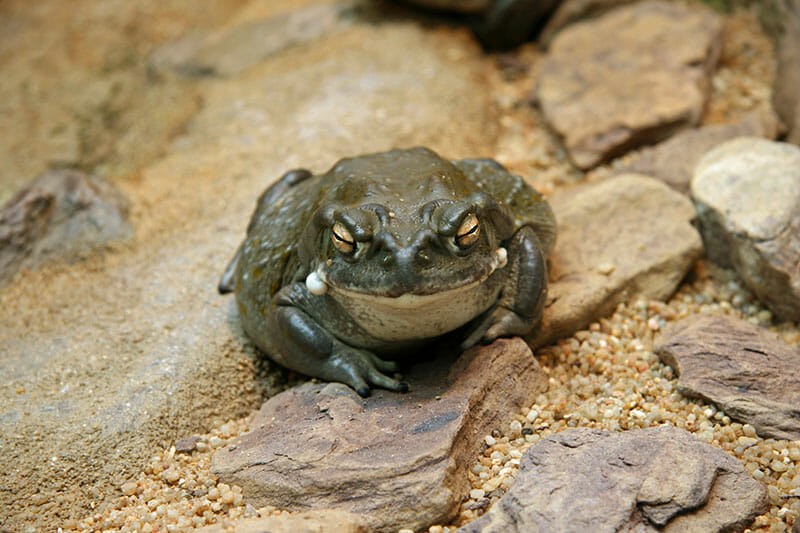
5-methoxydimethyltryptamine (5-MeO-DMT) is a potent, fast-acting, natural psychoactive indolealkymine substance, which acts as a serotonin (5-HT-1-A/5-HT-2A) receptor agonist (Shen, Jiang et al. 2010, Szabo, Kovacs et al. 2014). 5-MeO-DMT was initially isolated from the bark of Dictyoloma incanescens (Pachter 1959), and has also been found in the milky-white secretion that protects the Incilius Alvarius toad against predators (Weil and Davis 1994).
This toad, also known as Bufo Alvarius, has become well-known worldwide as a “5-MeO-DMT-making-machine”. Its secretion, when inhaled through vaporization, has proven to be powerfully psychoactive within 15 seconds, causing an experience of unity reported by participants in underground ceremonies in the most repeated soundbite “we are all one” (Weil and Davis 1994).
The presence of 5-MeO-DMT in the secretion is not the only substance that makes the toad so interesting. In fact, it is also the only species whose skin contains 5-methoxyindolealkylamines as well as 5-hydroxyindole-O-methyl transferase activity (Erspamer, Vitali et al. 1967). This enzyme, among other reactions, converts bufotenine (5-OH-DMT) to the potent hallucinogen 5-methoxy-N,N-dimethyltryptamine (5-MeO-DMT) (Weil and Davis 1994).
That being said, bufotoxins are the name of a collection of compounds which can be found on the toad’s skin, and in the two glands behind the eyes called the parotid glands (Tyler 1976). Several types of toxic and non-toxic substances can be found in the bufotoxins and they include the following; cardioactive agents such as for example bufagins (bufandienolides), catecholamines such as epinephrine and norepinephrine, indolealkylamines such as bufothionine, serotonin, cinobufotenine, bufotenine and dehydrobufotenine, and finally noncardiac sterols, which are non-toxic, such as cholesterol, provitamin D, gamma sitosteral and ergosterol (Chen and Kovaříková 1967). Moreover, as illustrated in the work for Erspamer and colleagues (1967) using paper chromatography, the bufotoxins include not only 5-MeO-DMT but also many other compounds. As previously mentioned, these compounds protect the toad from predators, and can, for this reason, have fatal consequences as demonstrated by reports of animals that have died after biting toads.
Sign up for our Introduction to Psychedelics Course!
Although these bufotoxins are a natural defense mechanism of the toad, humans have found a way of using them for a different purpose. At the present time, a number of people are smoking bufotoxins at underground ceremonies. Moreover, many also make use of 5-MeO-DMT from plant extract (i.e. yopo) or from a synthetic origin. A recent survey by Johns Hopkins demonstrates that use of 5-MeO-DMT, from either toad, plant extract or synthetic origin, is used infrequently and primarily for spiritual exploration (Davis, Barsuglia et al. 2018). Anecdotal, and empirical evidence demonstrates that people also use 5-MeO-DMT for treating psychiatric conditions such as depression, anxiety, posttraumatic stress disorder and substance abuse (Psychedelic Times, 2016). The resulting subjective effects appear to be due to the compounds ability to induce mystical experiences which have been demonstrated to have lasting beneficial effects (Garcia-Romeu, R Griffiths et al. 2014).
To be able to inhale the bufotoxins one would have to “milk the toad.” It is worth noting that the toads hibernate for most of the year, and generally appear just before summer showers, and congregate when the rains begin for reproduction (Fouquette Jr 1970). This is the time when they can be found and milked. The pamphlet titled “Bufo Alvarius, the Psychedelic Toad of the Sonoran Desert” outlines detailed instructions for collecting and drying the venom;
“You hold it [wearing gloves] over a flat glass plate or any other smooth, nonporous surface at least 12-inches square, the toad is held in front of the plate, which is fixed in a vertical position. In this manner, “the venom can be collected on the glass plate, free of dirt and liquid released when the toad is handled” (Most 1984).
Moreover, from the article Weil and Davis from 1994:
“One Bufo Alvarius yield 0.25-0.5 gram of dried venom. Since concentrations of 5-MeO-DMT may be as high as 15% one toad may yield 75 mg of an hallucogenic drug that, when smoked, is effective in humans at doses of 3-5 mg. In other words, a single toad produces 15 or more doses of one of the most potent psychoactive drugs found I nature. A matchbox sized container would represent thousands of effective doses.”
With this in mind, it is no wonder that the harvest and consumption of the toad’s bufotoxins have increased.
The harvesting of the toad’s bufotoxins happens not only from the hands of facilitators of ceremonies, or consumers but also from toad-hunters such as the ones filmed in “Hamilton’s Pharmacopeia: The Psychedelic Toad” who after harvesting the bufotoxins sell it (VICELAND 2017). In the video clip, the toad-hunters report that they have collected around 500 grams of bufotoxins over the years. This equals 5,000 doses if one dose is 100 milligrams of bufotoxin, and means that in order for one person to have the experience at least two toads must be milked.
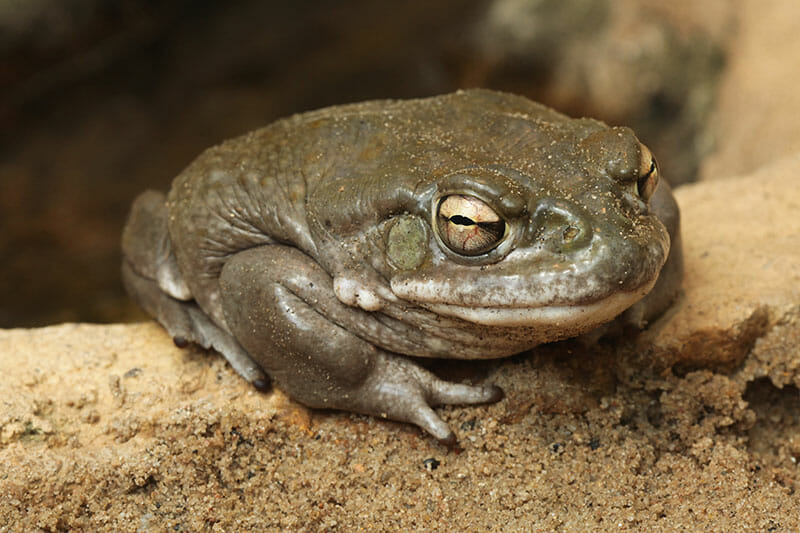
Now how does the harvesting and consumption of bufotoxins impact the toad?
At this point in time (October 2018) the toads are classified as “least concern” on the IUCN Red List of Threatened Species (Hammerson & Santos-Barrera, 2004). Although this may be true, these assessments are from 2004, and is therefore very likely to be outdated. A new assessment about the toad’s population size is highly warranted given the attention the toad has received and the consumption of the toads’ bufotoxins worldwide.
Nevertheless, it is not old news that the amphibian population worldwide is declining. Actually, their global decline was first recognized in the early 1990s (Wake 1991). As of 2010, 32% of the world’s nearly 6600 amphibian species are threatened with extinction, 43% are experiencing declines and for another 22%, there are insufficient data (Stuart, Chanson et al. 2004). This phenomenon represents the Earth’s sixth mass extinction (Wake and Vredenburg 2008). That being said, there is no single cause to the global amphibian decline, rather there may be several contributing factors (Hayes, Falso et al. 2010). As outlined in the paper by Hayes and colleagues, there are three levels of possible factors for the amphibian decline.
The first level involves 1) death (or removal) of individuals and 2) reduced recruitment within a population. (Editors note: recruitment occurs when juvenile organisms survive to be added to a population, by birth or immigration, usually a stage whereby the organisms are settled and able to be detected by an observer. Source – Wikipedia
The second level involves 1) increased disease rate, 2) decrease in nutrition, 3) predation, 4) human exploitation 5) “other mortality”, which represent everything from the death of older individuals, incidental death, to catastrophic events.
Finally, the third level involves 1) atmospheric change, 2) environmental pollutants, 3) habitat loss, 4) invasive species, and finally 5) pathogens. These levels are also suggested to interact with one another.
It is not rocket science that the above-mentioned factors also have an impact on the toad. The increasing demand for the bufotoxins for inhalation has made the toad susceptible to not only ecological disturbance through the invasion of habitat and excessive milking, but also amphibian-trafficking and black-market dynamics. Additionally, according to herpetologist Robert Anthony Villa, the largest toads are most likely to be spotted and collected over smaller toads, and if you remove the biggest toads, you remove the population’s ability to sustain itself as the bigger toads have a lot of eggs (Psychedelic Today 2018). Moreover, based on studies on snakes, we know that 80% of snakes die if you catch them, move them to a different territory and let them go. Similarly, toads have an inner-GPS that they rely on, and if a toad is taken out of their territory for milking, and then set free elsewhere, they are very likely to die because they are either simply lost, could get run over by a car, or eaten by predators. The latter is more likely to successfully happen when the toad has been deprived of their main defense mechanism.
Along with that, Villa reports that the toad is very likely to be impacted negatively by pathogens, such as for example chytridiomycosis, which is exposed to them by people when they are collected for milking and can spread to the rest of the toad population. Additionally, as the surviving toads depend on the genetic variety of other populations to sustain themselves, the toads would inbreed themselves to extinction if there are no other populations to copulate with. Finally, keeping a toad as a pet, or many in large conservations for breeding, is a huge disservice to the toad as they do not do well in captivity, and due to the factors previously stated.
Given the circumstances, it seems to me that the harvesting and consumption of bufotoxins or so-called “toad medicine” is very much the case of the “double effect” principle; with a good act, comes a bad consequence. The aforementioned are all alarming factors that could very well lead toward population decline and so to extinction. This is all startling information that calls for action.
A discontinuation of “toad medicine” in favor of synthetic 5-MeO-DMT use can diminish the current unnecessary and excessive harassment of the Incilius Alvarius species. Switching from using toad bufotoxin to synthetic 5-MeO-DMT is better for many other reasons. First, synthetic 5-MeO-DMT does not contain a cocktail of other compounds and is therefore much safer to use. Likewise, it will be much easier for researchers to re-schedule and legalize a pure substance for medical use than a complex bufotoxin. Second, synthetic 5-MeO-DMT is not any different from “toad-medicine”. In fact, the argument that “toad-medicine” is better than synthetic is a claim that is drawn from personal experience and is not a good enough argument to extend to a generality.
I personally think it is important that we start to reflect upon the implications our actions have on the toads and take action. It is not necessary to wait until the toads are classified as endangered before we act.
My hope and wish for the future is that all of us, be it, consumers, researchers, organizers, or facilitators, will think twice about whether experiencing 5-MeO-DMT at the expense of a species’ continued presence on this planet is worth it. Especially when there is an alternative way which is much safer to use, not any different from the effects of the bufotoxins, and does not contribute to ecocide.
The book “Homo Deus; A Brief History of Tomorrow” highlights several important and interesting topics. One of them is the power human beings have, and how this power can affect the future of the planet. One thing that Harari points out, which seems to be very fitting for this moment, is that humans have the capability to do many things, but that question is not “what we can do?”, but rather; “what should we do?” (Harari 2015).
References
Chen, K. and A. Kovaříková (1967). “Pharmacology and toxicology of toad venom.” Journal of pharmaceutical sciences 56(12): 1535-1541.
Davis, A. K., J. P. Barsuglia, R. Lancelotta, R. M. Grant and E. Renn (2018). “The epidemiology of 5-methoxy-N, N-dimethyltryptamine (5-MeO-DMT) use: Benefits, consequences, patterns of use, subjective effects, and reasons for consumption.” Journal of Psychopharmacology: 0269881118769063.
Erspamer, V., T. Vitali, M. Roseghini and J. M. Cei (1967). “5-Methoxy-and 5-hydroxyindoles in the skin of Bufo alvarius.” Biochemical pharmacology 16(7): 1149-1164.
Fouquette Jr, M. (1970). “Bufo alvarius.” Catalogue of American Amphibians and Reptiles (CAAR).
Garcia-Romeu, A., R. R Griffiths and M. W Johnson (2014). “Psilocybin-occasioned mystical experiences in the treatment of tobacco addiction.” Current drug abuse reviews 7(3): 157-164.
Harari (2015). Homo Deus: A Brief History of Tomorrow.
Hayes, T., P. Falso, S. Gallipeau and M. Stice (2010). “The cause of global amphibian declines: a developmental endocrinologist’s perspective.” Journal of Experimental Biology 213(6): 921-933.
Most, A. (1984). Bufo alvarius: The psychedelic toad of the Sonoran desert, Venom Press.
Pachter, I. J. Z., D.E.Ribeiro, O. (1959). “Indole alkaloids of acer saccharinum (the Silver Maple), Dictyoloma incanescens, Piptadenia colubrina, and Mimosa hostilis.” J Org Chem 24: 1285-1287.
Shen, H. W., X. L. Jiang, J. C. Winter and A. M. Yu (2010). “Psychedelic 5-methoxy-N,N-dimethyltryptamine: metabolism, pharmacokinetics, drug interactions, and pharmacological actions.” Curr Drug Metab 11(8): 659-666.
Stuart, S. N., J. S. Chanson, N. A. Cox, B. E. Young, A. S. Rodrigues, D. L. Fischman and R. W. Waller (2004). “Status and trends of amphibian declines and extinctions worldwide.” Science 306(5702): 1783-1786.
Szabo, A., A. Kovacs, E. Frecska and E. Rajnavolgyi (2014). “Psychedelic N, N-dimethyltryptamine and 5-methoxy-N, N-dimethyltryptamine modulate innate and adaptive inflammatory responses through the sigma-1 receptor of human monocyte-derived dendritic cells.” PloS one 9(8): e106533.
Psychedelic Today (2018). Psychedelic Today’s 5-MeO-DMT Course; https://psychedelicstoday.teachable.com/, Psychedelic Today (Unpublished).
Tyler, M. J. (1976). Frogs, Collins.
VICELAND (2017). The Psychedelic Toad. Hamiltons pharmacopeia. https://www.viceland.com/en_us/video/hamiltons-pharmacopeia-the-psychedelic-toad/59cd5cd7c6e1eb5725458fdc, Vice.
Wake, D. B. (1991). “Declining amphibian populations.” Science 253(5022): 860-861.
Wake, D. B. and V. T. Vredenburg (2008). “Are we in the midst of the sixth mass extinction? A view from the world of amphibians.” Proceedings of the National Academy of Sciences.
Weil, A. T. and W. Davis (1994). “Bufo alvarius: a potent hallucinogen of animal origin.” Journal of ethnopharmacology 41(1-2): 1-8.
About the Author

Malin Vedøy Uthaug is a Ph.D. student at the University of Maastricht, Department of Neuropsychology & Psychopharmacology. She has a background in health and social psychology and is currently researching psychedelic (ayahuasca, 5-MeO-DMT, DMT, and mescaline) and yoga-induced improvements of mental health. On the side of being a student and researcher, she is a life coach and public speaker. She started her coaching project titled Love & Gratitude in September 2016 which serves as a platform to spread information related to positive psychology, and transpersonal psychology. Love & Gratitude has also become a way to bring about information about psychedelics and help to destigmatize them. She has since September 2016 delivered talks, webinars and workshops in Belgium, The Netherlands, Czech Republic, Norway, United States of America, and Colombia.
You can find more from Malin on Psychedelics Today here.
